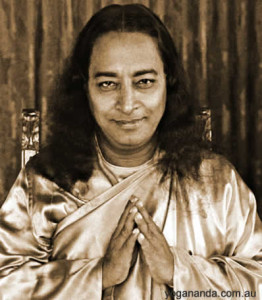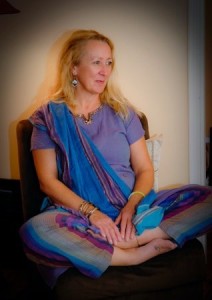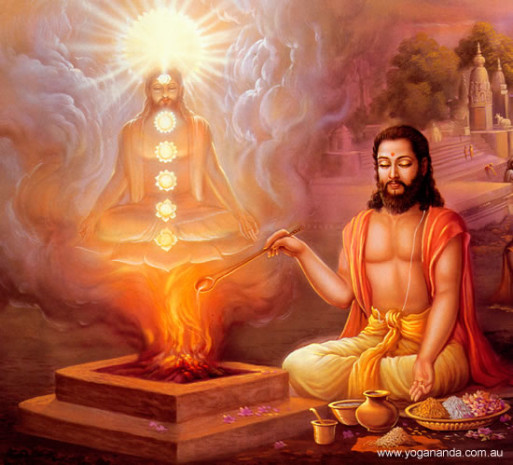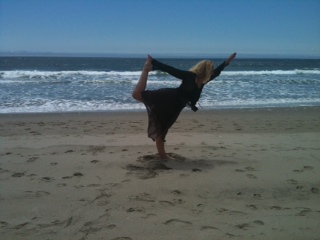Today, in this first part of a two-part interview, SevenPonds speaks with Camella Nair, a yoga teacher and swami born in England and based in California, about her spiritual journey through yoga over the past 30 years. Camella is certified in death midwifery and certified as an Ayurvedic health educator and a Ayurvedic yoga teacher. Camella shares her insights on the yogic path and accepting impermanence.
Ellary: Camella, you are a yoga teacher and a swami. Can you explain what a swami is?
Camella: Well a swami is supposed to be one who’s practicing self awareness all the time. It’s something that I got into as my studies were deepening and I was studying at the Temple of Kriya Yoga and I decided I wanted to go through the seminary. Becoming a swami was part of that, but a lot of the training was actually in coming to terms with death and dying. You know, [these are] the subjects that people don’t really like talking about much, even in the yoga community, where it’s supposed to be quite a big thing that we’re supposed to be looking at.
Ellary: Where is the Temple of Kriya yoga?
Camella: It’s in Chicago.
Ellary: And why do you say that in the yoga community death and dying is something that you’re supposed to be looking at?
Camella: Well, without getting sort of too technical and all the rest of it, there are some obstacles that as yoga people, as yogis, we’re supposed to be looking at, obstacles that get in the way of our enlightenment. We come into the world needing to feed our sense organs, and we sort of forget what it was what we came for at the very beginning. We start to develop an ego personality. An ego personality’s fine, we just need to sort of modify it somewhat. We create our lives based on things that we like, things that we don’t like, and develop prejudice and loyalty and things like that. And then of course when it comes to the sunset years of our lives, we’re supposed to be preparing for the next lifetimes, actually, probably seven lifetimes.
But most people don’t even like to talk about the subject of death and dying, though there’s no greater time to do it really than when we’re healthy. And so the last big obstacle that yoga people and actually everybody has to come to terms with is our mortality, and the temporality of the physical body. We all cling to it, we know that by how we try to prolong life at any cost. So it’s a big piece. And it’s great that we have so many people practicing yoga in this country, but they’re all concerned with being bendy, strong and all that kind of thing. It’s good to want wellness in our lives and to be healthy and everything, but there’s a huge piece that we’re still a little bit shy and reticent about looking at, and that is death and how we do cling to the body and want to take everything with us; it’s not possible. The only thing we have really is our memory track that seems to go on and on.
Ellary: You mentioned preparing for the next seven lifetimes. Where does the number seven come from?
Camella: It represents seven realms of consciousness. I was always taught that when you’re making your plan for your life, don’t just stay with this lifetime. Start to plan ahead, because everything takes time. On a mystical level, we can have anything that we want in life, we just have to be prepared to put the effort in to get it, to wait for it, because it takes time. We have to pay maybe some sacrifice, maybe make some sacrifice along the way; it’s not all instant mashed potatoes. Our society tends to want that more than anything. That’s why people want to take a pill rather than take care of their lives. Slow down, slow down the breath, rest more, play more, laugh more. They want to take a pill. Before you know it, you’ve got to take another pill to cancel out the side effects of the first pill, and it’s kind of a snowball effect, and we just can’t face the inevitable.
Ellary: What was your introduction to yoga?
Camella: Oh gosh, it was when I was about 16 or 17 in England. These were the days before sticky mats, and yoga music, and yoga clothes, and things like that, rock star yoga teachers. My mom just wanted me to go with her, so my mom actually introduced me to yoga. Shavasana was a big thing. This was in England, so it was cold in the winter, obviously. People would take pillows and sleeping bags and I would think, “What the hell is this that my mother’s taking me to?” I very quickly got into the practice of letting go and relaxation, and it was very different.
Now, there tends to be somewhat of a separation in the yoga community with people who are trying to differentiate fit-based yoga to therapeutic yoga, but we were brought up to think that it was all supposed to be therapeutic, and all part of an inclusion kind of modality. I used to study at a center that had people coming through with MS, Parkinson’s, and then drop-in classes as well. You didn’t say, “Well, this is a power yoga class and this is a gentle yoga class.” It was just do what you can. And then they had residential programs for people with special needs, but it was always part of the therapeutic modality in my universe.
Ellary: What was that center called?
Camella: It was the Yoga for Health Foundation, which sadly is not there anymore. It was founded by Howard Kent, and they were using a facility in the countryside. It was an old boys’ school, a private boys’ school, and then developers came in after a number of years. Despite the worldwide outcry, because [Kent] was quite famous, and what he was doing there with this therapeutic center was quite well-known, they just closed it down. That was in Ickwell in Bedfordshire. It was lovely, a really nice place. They had a yoga magazine called Yoga for Health, I think it was, and there weren’t like your usual bendy 20-year-old people doing some crazy, sexy pose on the front cover. It was a person in a wheelchair, a middle aged woman, an old man. That was my yoga, thank God.
Ellary: So the spiritual teachings and philosophy were a big part of the center?
Camella: Pranayama was a big part of the classes, and then we would do meditation at the end, probably about 10 minutes or something. But yeah, that was a big part of it, sitting and practicing Pranayama techniques as well as the asana.
Ellary: How did your mom get into it?
Camella: It’s one of those things. Sometimes we don’t know, we all have these likes, and very often we don’t know where they come from, but they come from perhaps previous lives. Why do you have two kids and one of them likes mint ice cream and the other one likes chocolate? Where does it stem from? Where does it come from? Past experiences that we assimilate and we start to develop an aversion or a like for something. I think it can last with lifetimes actually. I expect that she was probably a yoga person in a previous lifetime, or something like that. Who knows? When the door opens, we go through it or we don’t. She was very passionate about it, but she was into aromatherapy and natural healing and things like that as well when it was very sort of woo-woo and different. She’s still alive, she’s in her 70s and doing quite well. But yeah, it’s one of those things that wasn’t really a household word or anything. She was actually the one that gave me Autobiography of a Yogi.

Paramahansa Yogananda, founder of Kriya Yoga and author of Autobiography of a Yogi
(Credit: yogananda.com.au)
Ellary: Was that a really impactful book for you?
Camella: Yeah, I think it was. I enjoyed it. It’s a little bit sort of out there, isn’t it? But that’s what people want, they want miracles. They don’t want, “This is what you need to do, you need to learn to stand on your own two feet, stop blaming everybody else.” They want a course in miracles, and someone to do it for them. Even in the yoga community, they want a teacher who’s going to give them a blessing, a diksha, and all of a sudden they’ve become enlightened. It doesn’t work like that. We’ve got to get a backpack, a rucksack with all the things in it, a sturdy pair of boots, and start climbing the mountain ourselves. We gain our own enlightenment, and wisdom, and compassion, and all the rest of it. It’s not easy, it’s not an easy path, but hopefully it becomes enjoyable knowing that we’re on some sort of path rather than just blowing around with no goal in life. That’s the sad part. A lot of the younger generation, they’re so lost because everything’s so hard for them. I mean nothing’s long term. When I first started working, people were in jobs for life. It doesn’t work like that anymore. It’s a very fragile economy where there isn’t that sense of security anymore.
Ellary: Right, there’s a lot of volatility. That’s something that yoga can help you hold space for.
Camella: Right, it’s all connected. How we breathe — shallow breathing creates erratic thoughts. I mean, I think we know it on an instinctual level. If we have a kid that comes in crying and screaming and sobbing, we say, “Slow, down. Just slow down.” We don’t have to be yoga people to know that. I think it’s just common sense. It’s just that we’re so busy in our lives that we kind of forget.
Ellary: Your yoga path started at a pretty young age. Is that something you’ve ever diverted from at any point and then come back to and recommitted?
Camella: Yeah I think so, because I got into the workplace; I was in marketing. Then I came back to yoga fully, and wanted to study more fully with a spiritual teacher. When my kids were very small, and when I came to California, it was just everywhere. I recognized pictures of Paramahansa Yogananda because he was such a presence here. I started reading, started studying and found a teacher. I think it deepened quite substantially some 20 years ago. There are times when we get spiritual indigestion, and we don’t feel quite so spiritual, quite so noble. That’s OK, but the thing is once you start, once you know that you need to be better, then there’s no getting out. We’re our own judge and jury. You say, “Well, I’ll try and do better next time.” We’re just human, after all.
Ellary: When did you start studying at the Temple of Kriya yoga?
Camella: Probably about 15 years ago.
Ellary: And what led you to Kriya yoga? What is Kriya yoga?
Camella: Kriya yoga is the only yoga that they talk about in the yoga sutras. It comes from the word “kri,” which means action. In book two of the yoga sutras, Patanjali says that yoga is Kriya yoga, which is the yamas and the niyamas, the things that we’re supposed to not do and do. The last of the three niyamas, the things that we’re supposed to cultivate in our lives, are things like self-study, self-discipline and an atunement to something other than ourselves. That just means that we’re not really the physical body; there’s something out there that’s quite marvelous and wonderful. It hasn’t got a name, it hasn’t got a form, but it’s part of us intrinsically. So Kriya yoga is self-discipline, self-study and an awareness that there is something quite magical in the universe that permeates everything.
Ellary: Do you think that you really need to tap into that and integrate that belief, that mystery?
Camella: I’m continually thinking about that. I’m the master of my own universe. If anything’s not going right in my universe, it’s my own fault. It’s my unawareness that probably caused the problem in the first place. But it gives us tools to do things better next time if we want to. That’s the difference between someone who wants to walk the path consciously as opposed to somebody who’s unconscious and who doesn’t really have a spiritual path at all. Sure, we all become enlightened eventually. But the person who decides that they want to walk a spiritual path, it’s like, “Well, I don’t want to go through all that pain and suffering and unconsciousness, and things are coming into my life.” I’m thinking, “Well, hang on a minute. How did I get here?” It’s having a little bit more control.
Of course things get difficult, of course karma gets interesting. We have a responsibility and an ability to change our attitude. You have two people who’ve been told they’ve got six months to live. One of them is gonna say, “Wow, that’s it. I’m gonna live every day like it’s the last day, and enjoy myself for these next six months.” Another person could say, “I’m gonna whine, moan and complain to everybody, and go out kicking and screaming.” It’s a question of one’s attitude.
Ellary: Do you work particularly with people dealing with terminal illness or facing end-of-life situations?
Camella: I did volunteer work in hospice when I was in seminary, but I find that, especially when you get to a certain age, you come across people who are sick or dying just because of the natural progression of life and death. A lot of my students, they’re not in their 20s or their 30s. They’re maybe late 40s all the way through 80s. We lose a few people along the way; people get sick. You’ve built communities, so you can’t help having that discussion, and that piece going around. I think a lot of the rituals that I do when we gather women together for the summer solstice and the winter solstice, we talk about our goals in life. The winter solstice we’ll be celebrating on December 21st, and we talk about the ending of things. It’s just another opportunity to begin once again. You can only go so far into the darkness, and then it will become light again
Ellary: So you hold women’s solstice rituals?
Camella: Yes, we come together for the summer solstice. For the winter solstice, we practice the 108 sun salutations on the solstices and the equinoxes. Just after Halloween, on the day of All Souls, All Saints, we usually come together and do something. This year we came together and did the ritual of forgiveness and yoga nidra. It was pretty powerful.
Ellary: On your website, you have a couple things that you do that are specifically related to death and dying. You have your Good Death Cafe Facebook group and your Death Insight and Conversation Cards, so that’s something that you do work around, specifically.
Camella: Yeah, I think it’s just that as I’m trying to mature in my practice, I’m realizing that I have to face that piece. My parents are still alive, and the natural order of things is that they go before me. Everything we do has some self-investigation in it, so what I’m doing in this field is hopefully going to help me when the time comes for me to say goodbye, if it works out that way. We’ll never know, but I don’t relish the idea of separation. Everybody has to face that. We have to let go of the people that we love. We come into this world with nothing, and we certainly leave it with nothing.
Ellary: Your Good Death Cafe is a space for people to talk about those issues?
Camella: Yeah, so people can post things, and share ideas, and try to break the taboo around death. Obviously there’s this big movement with the Death Cafe scene. That’s there for people to contribute to, and who knows when these seeds will germinate, and what it’s going to mean in people’s lives. You never really know. It’s quite interesting.
Come back next week for part two of our interview with Camella Nair!

 How Can Yoga Help Us Confront Death? An Interview with Camella Nair, Part One
How Can Yoga Help Us Confront Death? An Interview with Camella Nair, Part One





 Our Monthly Tip: Make an “In Case of Death” File to Ease Loved One’s Grief
Our Monthly Tip: Make an “In Case of Death” File to Ease Loved One’s Grief
 Passing of Beloved Comedian Births a New Comedy Festival
Passing of Beloved Comedian Births a New Comedy Festival















